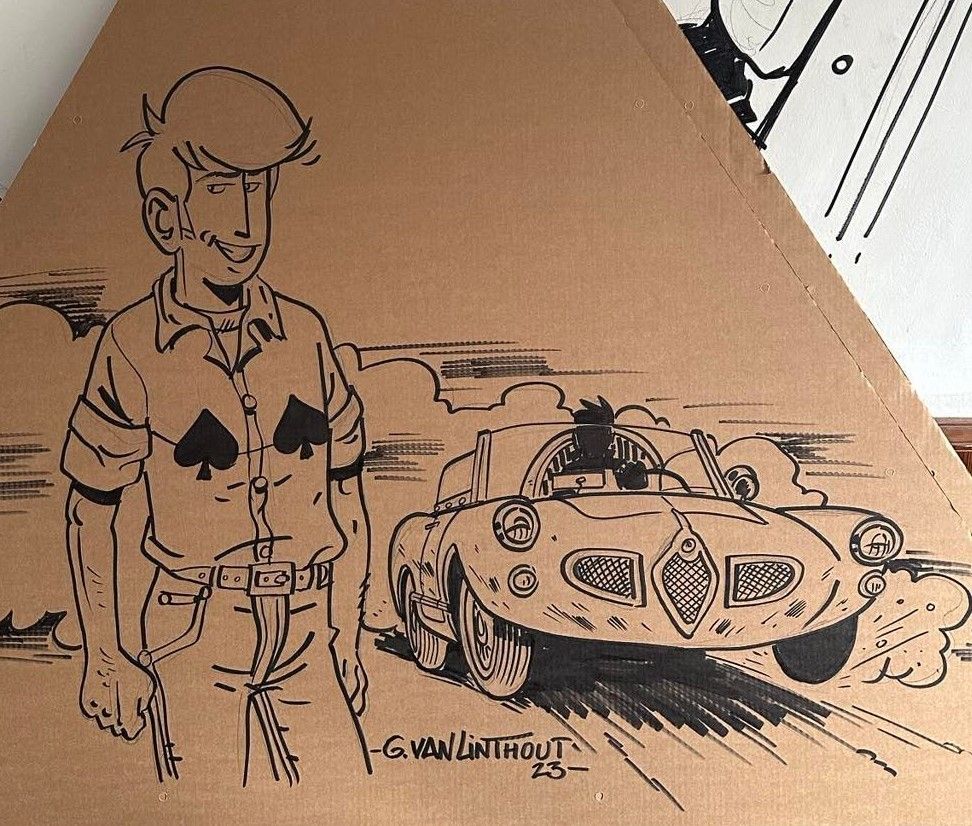Description
Georges Van Linthout. Original felt-tip artwork exclusively in aid of the "Une tente une vie" operation, on cardboard. Signed. Wood frame with Plexiglas glass included: 155 x 125 cm Born on December 21, 1958. From kindergarten onwards, he discovered his love of storytelling, filling his notebooks with his own comic strips, Jean and his gang. He studied visual arts and illustration at the Institut Saint-Luc in Liège, and sold his first strips to the Spirou newspaper in 1982. He does his military service. In 1985, he created Lou Smog, an American police lieutenant in the 1950s, for Tintin, a series that ran for 8 issues. He collaborated on several Natachas, designing the sets. Then, with Yves Leclercq on the script, he drew the Falkenberg series, which ran for three albums from 1997 to 1999. Parallel to this activity, he worked with Stibane (his twin brother) and Didgé on an album released at the end of 1995: Jenny, sold by Belgian associations helping children in difficulty. In 2001, Van Linthout published the Twins detective series with Leclercq on the script for Casterman; the series ran for three albums until 2003. In 2005, again with Yves Leclerq, he published Conquistador in the Romans collection with Casterman. Together again in 2007, they produced a biography of T-Bone Walker for Editions Nocturne, featuring a design in the same vein as the Conquistador album. In 2008, for the Rivages/Casterman/Noir collection, they collaborated on the adaptation of Budd Schulberg's novel Sur les quais. In early 2010, he published Braquages Bras Cassés with Benjamin Fischer on the screenplay. In 2016, he began publishing the Brian Bones series based on a script by Rodolphe (four albums, Éditions Paquet coll. "Calandre"). In 2022, he draws the comic book adaptation of David Vann's novel Goat Mountain on a script by his daughter O. Carol, published by Philéas. The ORIG-AMI is a cardboard shelter measuring 117 x 235 x 150 cm. It is insulating, structurally protective, foldable like an accordion, transportable like a backpack and recyclable. The homeless shelter was designed on the principle of origami, a Japanese paper-folding technique.
17
Online
Georges Van Linthout. Original felt-tip artwork exclusively in aid of the "Une tente une vie" operation, on cardboard. Signed. Wood frame with Plexiglas glass included: 155 x 125 cm Born on December 21, 1958. From kindergarten onwards, he discovered his love of storytelling, filling his notebooks with his own comic strips, Jean and his gang. He studied visual arts and illustration at the Institut Saint-Luc in Liège, and sold his first strips to the Spirou newspaper in 1982. He does his military service. In 1985, he created Lou Smog, an American police lieutenant in the 1950s, for Tintin, a series that ran for 8 issues. He collaborated on several Natachas, designing the sets. Then, with Yves Leclercq on the script, he drew the Falkenberg series, which ran for three albums from 1997 to 1999. Parallel to this activity, he worked with Stibane (his twin brother) and Didgé on an album released at the end of 1995: Jenny, sold by Belgian associations helping children in difficulty. In 2001, Van Linthout published the Twins detective series with Leclercq on the script for Casterman; the series ran for three albums until 2003. In 2005, again with Yves Leclerq, he published Conquistador in the Romans collection with Casterman. Together again in 2007, they produced a biography of T-Bone Walker for Editions Nocturne, featuring a design in the same vein as the Conquistador album. In 2008, for the Rivages/Casterman/Noir collection, they collaborated on the adaptation of Budd Schulberg's novel Sur les quais. In early 2010, he published Braquages Bras Cassés with Benjamin Fischer on the screenplay. In 2016, he began publishing the Brian Bones series based on a script by Rodolphe (four albums, Éditions Paquet coll. "Calandre"). In 2022, he draws the comic book adaptation of David Vann's novel Goat Mountain on a script by his daughter O. Carol, published by Philéas. The ORIG-AMI is a cardboard shelter measuring 117 x 235 x 150 cm. It is insulating, structurally protective, foldable like an accordion, transportable like a backpack and recyclable. The homeless shelter was designed on the principle of origami, a Japanese paper-folding technique.
You may also like
